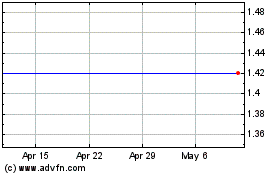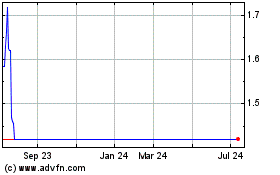Nabriva Therapeutics plc (NASDAQ: NBRV), a biopharmaceutical
company engaged in the commercialization and development of
innovative anti-infective agents to treat serious infections,
announced today that the Journal of the American Medical
Association (JAMA) has published results from the company’s
Lefamulin Evaluation Against Pneumonia 2 (LEAP 2) clinical trial.
The U.S. Food and Drug Administration (FDA) approved lefamulin on
August 19, 2019 under the brand name XENLETA™, which is now
available for the treatment of adults with CABP. XENLETA is
the first IV and oral antibiotic with a novel mechanism of action
approved by the FDA in nearly two decades.
In the study, the second of two global, pivotal Phase 3 clinical
trials of lefamulin, clinicians evaluated the safety and efficacy
of five days of oral lefamulin compared to seven days of oral
moxifloxacin, a respiratory fluoroquinolone, in adult patients with
moderate CABP (PORT risk class II, III, or IV). In this study, a
short course (5-days) of lefamulin was shown to be noninferior to a
7-day regimen of moxifloxacin for the treatment of CABP. Lefamulin
achieved high clinical response rates for both typical
(Streptococcus pneumoniae - including multi-drug resistant strains,
Haemophilus influenzae, Moraxella catarrhalis, and Staphylococcus
aureus), as well as atypical pathogens (Mycoplasma pneumoniae,
including macrolide-resistant strains, Chlamydophila pneumoniae,
and Legionella pneumophila). Both lefamulin and moxifloxacin were
generally well tolerated with low and similar incidence of
discontinuations due to adverse events.
“The increasing prevalence of antimicrobial resistance in the
most common causative pathogens of CABP, along with growing
evidence of safety concerns with fluoroquinolones makes a
compelling case for the development of new antibacterial classes
with novel mechanisms of action (MOA) to treat patients with CABP,”
said Jennifer Schranz, MD, Chief Medical Officer of Nabriva
Therapeutics. “Xenleta is the first novel MOA antibiotic approved
in the United States in nearly 20 years. The results from the LEAP
clinical trial program, combined with lefamulin’s targeted spectrum
of activity, which aligns with the principles of antimicrobial
stewardship, make it an attractive short-course, monotherapy
treatment option for adults with CABP.”
The publication, entitled “Oral Lefamulin vs Moxifloxacin for
Early Clinical Response Among Adults with Community-Acquired
Bacterial Pneumonia: The LEAP 2 Randomized Clinical Trial,” is
available online.
In a related editorial published in the same edition, entitled
“Lefamulin – A New antibiotic for Community-Acquired Pneumonia,”
author Preeti N. Malani, MD, MSJ, Division of Infectious Diseases
at the University of Michigan and Associate Editor of JAMA, states
“…lefamulin is an important addition to the current antibiotic
armamentarium, especially because bacterial pneumonia remains one
of the most common indications for antibiotic use.”
LEAP 2 Study
The Phase 3, double-blind, double-dummy, parallel-group,
noninferiority randomized trial was conducted in 99 sites in 19
countries. The clinical trial randomized 738 patients 18 years of
age or older who had had Pneumonia Outcomes Research Team (PORT)
risk class II, III, or IV, radiographically documented pneumonia,
acute illness, greater than three CABP symptoms, and greater than
two vital sign abnormalities. Randomization was stratified by PORT
risk class (II vs III/IV), geographic region (US vs ex-US), and
prior receipt of a single dose of short-acting antibiotic therapy
for CABP (yes vs no). Per protocol, ≤25 percent of the study
population could have received a single dose of a short-acting
antibiotic, and ≥50 percent were to have PORT risk class of III or
IV. The first patient visit was on August 30, 2016, and patients
were followed for 30 days, with the final date of follow-up on
January 2, 2018.
Patients were randomized 1:1 to receive oral lefamulin (600 mg
every 12 hours for 5 days; n = 370) or moxifloxacin (400 mg every
24 hours for 7 days; n = 368).
The primary endpoint for the study was early clinical response
(ECR) at 96±24 hours after the first dose of either study drug in
the intent-to-treat (ITT) population (all randomized patients).
Responders were defined as alive, showing improvement in greater
than two or more of the four CABP symptoms, having no worsening of
any CABP symptoms, and not receiving any non-study antibacterial
drug for current CABP episode. The European Medicines Agency
coprimary endpoints (FDA secondary endpoints) were investigator
assessment of clinical response (IACR) at test-of-cure (TOC; 5–10
days after last dose) in the modified ITT (mITT; randomized and
received any amount of study drug) population and in the clinically
evaluable (CE; met pre-defined inclusion/exclusion criteria,
minimal dosing requirements) population. The noninferiority margin
was 10 percent for ECR and IACR.
Study results showed that ECR rates were 90.8 percent with
lefamulin and 90.8 percent with moxifloxacin, meeting the
noninferiority margin of 10 percent. IACR rates were 87.5 percent
with lefamulin and 89.1 percent with moxifloxacin in the modified
ITT population and 89.7 percent and 93.6 percent, respectively, in
the clinically evaluable population at test of cure. Lefamulin was
well tolerated during the trial. The most frequently reported
treatment-emergent adverse events for lefamulin were diarrhea,
nausea and vomiting, predominantly mild to moderate, manageable and
which rarely led to discontinuation.
“The results from this randomized clinical trial will
inform more clinicians of lefamulin’s potential as an
effective alternative to commonly used antibiotics, such as
fluoroquinolones or macrolides, to fight community acquired
pneumonia, which affects five million Americans each year,” said
Gregory Moran, MD., Chief, Olive View-UCLA Medical Center.
About XENLETA
XENLETA (lefamulin) is a first-in-class semi-synthetic
pleuromutilin antibiotic for systemic administration in humans
discovered and developed by the Nabriva Therapeutics team. It is
indicated for the treatment of adults with CABP caused by the
following susceptible microorganisms: Streptococcus pneumoniae,
Staphylococcus aureus (methicillin-susceptible isolates),
Haemophilus influenzae, Legionella pneumophila, Mycoplasma
pneumoniae, and Chlamydophila pneumoniae. It is designed to inhibit
the synthesis of bacterial protein, which is required for bacteria
to grow. XENLETA’s binding occurs with high affinity and high
specificity at molecular sites that are different than other
antibiotic classes, resulting in a lower risk of developing
resistance and cross-resistance to other commonly used
antibiotics.
About Nabriva Therapeutics plc
Nabriva Therapeutics is a biopharmaceutical company engaged in
the commercialization and development of innovative anti-infective
agents to treat serious infections. Nabriva Therapeutics received
U.S. Food and Drug Administration approval for XENLETA™ (lefamulin)
for community-acquired bacterial pneumonia (CABP). Nabriva
Therapeutics is also developing CONTEPO™ (fosfomycin) for
injection, a potential first-in-class epoxide antibiotic for
complicated urinary tract infections (cUTI), including acute
pyelonephritis. For more information, please visit
www.nabriva.com.
INDICATION AND IMPORTANT SAFETY INFORMATION
INDICATION
XENLETA is a pleuromutilin antibacterial indicated for the
treatment of adults with community-acquired bacterial pneumonia
(CABP) caused by the following susceptible microorganisms:
Streptococcus pneumoniae, Staphylococcus aureus
(methicillin-susceptible isolates), Haemophilus influenzae,
Legionella pneumophila, Mycoplasma pneumoniae, and Chlamydophila
pneumoniae.
USAGE
To reduce the development of drug-resistant bacteria and
maintain the effectiveness of XENLETA and other antibacterial
drugs, XENLETA should be used only to treat or prevent infections
that are proven or strongly suspected to be caused by susceptible
bacteria.
IMPORTANT SAFETY INFORMATION
CONTRAINDICATIONS
XENLETA is contraindicated in patients with known
hypersensitivity to XENLETA or pleuromutilins.
XENLETA tablets are contraindicated for use with CYP3A4
substrates that prolong the QT interval.
WARNINGS AND PRECAUTIONS
XENLETA has the potential to prolong the QT interval. Avoid
XENLETA in patients with known QT prolongation, ventricular
arrhythmias, and patients receiving drugs that may prolong the QT
interval.
Based on animal studies, XENLETA may cause fetal harm. Advise
females of reproductive potential of the potential risk to the
fetus and to use effective contraception.
Clostridium difficile-associated diarrhea (CDAD) has been
reported with nearly all systemic antibacterial agents, including
XENLETA, with severity ranging from mild diarrhea to fatal colitis.
Evaluate if diarrhea occurs.
ADVERSE REACTIONS
The most common adverse reactions (≥2%) for (a) XENLETA
Injection are administration site reactions, hepatic enzyme
elevation, nausea, hypokalemia, insomnia, and headache and (b)
XENLETA Tablets are diarrhea, nausea, vomiting, and hepatic enzyme
elevation.
USE IN SPECIFIC POPULATIONS
In patients with severe hepatic impairment, reduce the dosage of
XENLETA Injection to 150 mg infused over 60 minutes every 24 hours.
XENLETA Tablets are not recommended in patients with moderate or
severe hepatic impairment due to insufficient information to
provide dosing recommendations.
Avoid XENLETA Injection and Tablets with concomitant strong or
moderate CYP3A or P-gp inducers. Monitor for reduced efficacy of
XENLETA.
Avoid XENLETA Tablets with strong CYP3A or P-gp inhibitors.
Monitor for adverse reactions of sensitive CYP3A substrates
administered with XENLETA Tablets.
XENLETA has not been studied in pregnant women. Verify pregnancy
status in females prior to initiating XENLETA and advise females to
use contraception during treatment and for 2 days after the final
dose. Lactating women should pump and discard milk for the duration
of treatment with XENLETA and for 2 days after the final dose.
To report SUSPECTED ADVERSE REACTIONS, or administration during
pregnancy, contact Nabriva Therapeutics US, Inc. at 1-855-5NABRIVA
or FDA at 1-800-FDA-1088 or www.fda.gov/medwatch.
Please see Full Prescribing Information for
XENLETA.
Forward-Looking Statements
Any statements in this press release about future expectations,
plans and prospects for Nabriva Therapeutics, including but not
limited to statements about launch and commercialization of XENLETA
for the treatment of CABP, marketing exclusivity and patent
protection for XENLETA, the development of CONTEPO for cUTI, the
clinical utility of XENLETA for CABP and of CONTEPO for cUTI, plans
for and timing of the review of regulatory filings for CONTEPO,
efforts to bring XENLETA and CONTEPO to market, the market
opportunity for and the potential market acceptance of XENLETA for
CABP and CONTEPO for cUTI, the development of XENLETA and CONTEPO
for additional indications, the development of additional
formulations of XENLETA and CONTEPO, plans to pursue research and
development of other product candidates, the sufficiency of Nabriva
Therapeutics’ existing cash resources and other statements
containing the words “anticipate,” “believe,” “estimate,” “expect,”
“intend,” “may,” “plan,” “predict,” “project,” “target,”
“potential,” “likely,” “will,” “would,” “could,” “should,”
“continue,” and similar expressions, constitute forward-looking
statements within the meaning of The Private Securities Litigation
Reform Act of 1995. Actual results may differ materially from those
indicated by such forward-looking statements as a result of various
important factors, including: Nabriva Therapeutics’ ability to
successfully implement its commercialization plans for XENLETA and
whether market demand for XENLETA is consistent with its
expectations, Nabriva Therapeutics’ ability to build and maintain a
sales force and prepare for commercial launch of XENLETA on the
timeline expected, or at all, the content and timing of decisions
made by the U.S. Food and Drug Administration and other regulatory
authorities, the uncertainties inherent in the initiation and
conduct of clinical trials, availability and timing of data from
clinical trials, whether results of early clinical trials or
studies in different disease indications will be indicative of the
results of ongoing or future trials, uncertainties associated with
regulatory review of clinical trials and applications for marketing
approvals, the availability or commercial potential of CONTEPO for
the treatment of cUTI or of XENLETA for the treatment of CABP, the
ability to retain and hire key personnel, the sufficiency of cash
resources and need for additional financing and such other
important factors as are set forth in Nabriva Therapeutics’ annual
and quarterly reports and other filings on file with the U.S.
Securities and Exchange Commission. In addition, the
forward-looking statements included in this press release represent
Nabriva Therapeutics’ views as of the date of this press release.
Nabriva Therapeutics anticipates that subsequent events and
developments will cause its views to change. However, while Nabriva
Therapeutics may elect to update these forward-looking statements
at some point in the future, it specifically disclaims any
obligation to do so. These forward-looking statements should not be
relied upon as representing Nabriva Therapeutics’ views as of any
date subsequent to the date of this press release.
CONTACTS:
For Investors Gary Sender Nabriva Therapeutics
plc ir@nabriva.com
For Media Mike Beyer Sam Brown Inc.
mikebeyer@sambrown.com 312-961-2502
Nabriva Therapeutics (NASDAQ:NBRV)
Historical Stock Chart
From Mar 2024 to Apr 2024

Nabriva Therapeutics (NASDAQ:NBRV)
Historical Stock Chart
From Apr 2023 to Apr 2024
